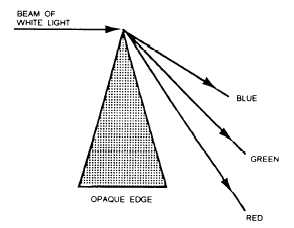Figure 1-8.–The law of refraction.
Figure 1-9.–Diffraction.
the index of refraction for that substance; for example,
light travels about 1 1/2 times as fast in air as it does in
glass, so the index of refraction for glass is about 1.5.
Refraction, or change of direction, always follows
a simple rule.
“In passing from one transparent substance into
another of greater density, refraction is toward the
normal. In passing from one transparent substance into
another of lesser density, refraction is away from the
normal.”
In this rule the normal is defined as a line
perpendicular (90°) to the surface between the mediums.
Refraction is shown in figure 1-8. The ray of light
(AB) strikes the glass at an oblique angle. Since the glass
is denser than air, the ray of light is bent toward the
normal (RS) and emerges from the glass at (C). Upon
entering the air again, the ray is bent away from normal
(RS) and travels along the path (CD).
All rays striking the glass at an angle other than
perpendicular are refracted. In the case of the
perpendicular ray (ME) that enters the glass normal to
the surface, no refraction takes place and the ray
continues through the glass and into the air in a straight
line.
DISPERSION
The speed of light in a medium depends on the
wavelength of the light. As light enters a more dense
medium, the short waves, such as blue, are slowed more
than the long waves, such as red. Thus the index of
refraction of a medium varies with the wavelength, and
the different colors of light are bent different amounts.
This changing index of refraction or the breaking up of
white light into its component colors is called
dispersion. This then ties in with the previous discussion
of the colors of light where we saw the way a prism
creates a spectrum from white light. The prism is able
to create this spectrum because of dispersion.
DIFFRACTION
We have said that light travels in a straight line. Well,
that is not always true. An exception to this rule occurs
when light travels close to an opaque edge. Because of
the wave nature of their travel, light rays passing near
an opaque edge are bent ever so slightly (fig. 1-9). This
bending is called diffraction and is evidenced by the
formation of a shadow with a fuzzy edge when light
passes an opaque object. In this case, the outside edge
of the shadow is light and indistinct, but it gradually
darkens into the true black of the shadow that indicates
that some of the light is scattered into the shadow area.
Unlike refraction, in diffraction the long wave-
lengths of light are bent the most.
Diffraction is important to the photographer when
the light passes the edges of a lens diaphragm. When the
lens diaphragm is opened fully, the amount (actually the
percentage) of diffracted light is quite small. But when
the diaphragm is closed to a small opening, the
percentage of diffracted light is quite large and reduces
the sharpness of the image formed by the lens. In other
words, a small aperture opening interferes with the
image-forming light more than a large aperture does.
POLARIZATION
Energy in the form of wave motion radiates from its
source and travels through a medium. For example,
1-6


